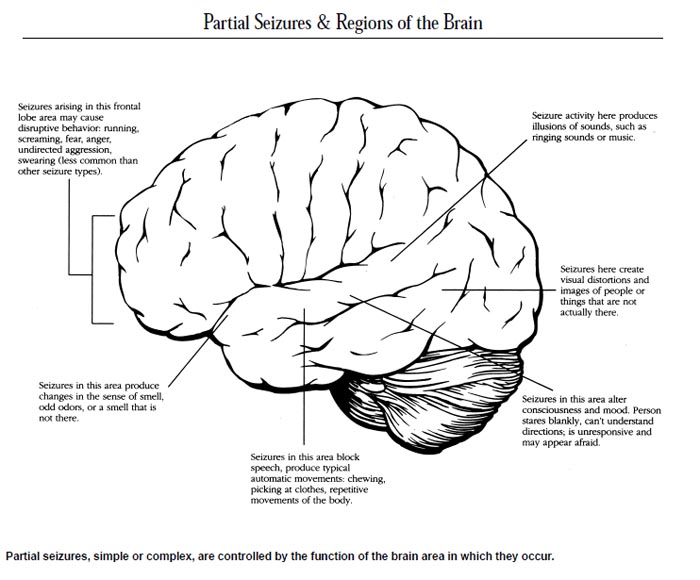Focal Impaired Awareness Seizures (Complex Partial Seizures)

Learn More:
Donate to Support Our MissionWhat Is A Focal Impaired Awareness Seizure?
A focal onset seizure begins in one side of the brain. We used to call these partial seizures. Focal onset seizures are the most common type of seizures in adults with epilepsy.
When the seizure begins in one side of the brain and the person has confusion or a change in their level of awareness during some or all of it, it is called a focal impaired awareness seizure.
- This type of seizure was previously called a complex partial seizure.
Learn about seizures with no loss of awareness, called focal aware seizures (previously simple partial seizures).
Where Do Focal Impaired Awareness Seizures (Complex Partial Seizures) Usually Start?
- These seizures usually start in one area or group of brain cells, most often in the temporal lobe or frontal lobe of the brain. They can also start in other areas too.
- The seizures starting in the frontal lobe tend to be shorter than the ones from the temporal lobe.
- Focal seizures can include involuntary movements called automatisms (aw-TOM-ah-TIZ-ums) like rubbing of the hands, lip-smacking, and chewing. When they involve the frontal lobes, you may see bicycling of the legs, pelvic thrusting, or other complex movements.
- Some focal impaired awareness seizures (usually ones beginning in the temporal lobe) start with a focal aware seizure (previously call simple partial seizure). This is commonly called an aura.
- In this case, the focal aware seizure quickly involves other areas of the brain that affect alertness and awareness.
- The person loses awareness and stares blankly. Even though their eyes are open, and they may make movements that seem to have a purpose, in reality "nobody's home."
- If the symptoms are subtle, other people may think the person is just daydreaming.
- Awareness may be only partially impaired, rather than absent. Any decrease in awareness of the self or environment at any time during a seizure makes it a focal impaired awareness seizure.
- A person's ability to respond may be impaired. Some seizures make the person unable to move yet still aware of what is happening around them.
- Impairment of awareness is like the concept of impairment of consciousness.
- Some focal impaired awareness (complex partial) seizures can spread to both sides of the brain. Previously called secondarily generalized seizures, the new name for this is focal to bilateral tonic-clonic seizures.
- They usually last between 30 seconds and 3 minutes.
- Afterward, the person may be tired or confused for about 15 minutes and may not return to normal function for hours.
What Does A Typical Focal Impaired Awareness Seizure Look Like?
Here’s a typical story of someone having a focal impaired awareness (complex partial) seizure:
"Susan's seizures usually occur while she's asleep. She makes a grunting sound, as if she's clearing her throat. Then she'll sit up in bed, open her eyes, and stare. She may clasp her hands together. If I ask her what she's doing, she doesn't answer. After a minute or so, she lies down and goes back to sleep."
- Some people can have seizures of this kind without realizing anything has happened.
- The seizure can wipe out memories of events just before or after it.
- Most people move their mouth, pick at the air or their clothing, or perform other involuntary purposeless actions (automatisms). Occasionally, people just freeze up and stare.
- Less often, people may repeat words or phrases, laugh, scream, or cry.
- Some people do things during these seizures that can be dangerous or embarrassing, such as walking into traffic or taking their clothes off. These people need to plan ahead and take safety precautions.
Who Is At Risk For Focal Impaired Awareness Seizures (Complex Partial Seizures)?
Anybody can get them. They may be more likely in people who have had a head injury, brain infection, stroke, or brain tumor. Often though, the cause is unknown.
How Can I Tell If Someone Is Having A Focal Impaired Awareness Seizure? How Often Will They Happen?
Focal impaired awareness (complex partial) seizures sometimes resemble either daydreaming or (absence) seizures. Review the following questions to learn some of the differences. Download a table with these questions and talk to your health care provider about your seizures.
How frequent are the episodes?
- When it’s a focal impaired awareness seizure: Rarely more than several times per day or week
- When it’s an absence seizure: Often seen multiple times per day
In what situations do they occur?
- When it’s daydreaming: Boring situation
- When it’s a seizure: Any time, including during physical activity
Do they begin abruptly?
- When it’s daydreaming: No
- When it’s a seizure: Usually yes. Some focal impaired awareness seizures begin slowly with a warning.
Can they be interrupted?
- When it’s daydreaming: Yes
- When it’s a seizure: Usually not
How long do they last?
- When it’s daydreaming: Until something interesting happens
- When it’s a focal impaired awareness seizure: Up to several minutes
- When it’s an absence seizure: Rarely more than 15-20 seconds
Does the person do anything during the episode?
- When it’s daydreaming: Probably just stares
- When it’s a focal impaired awareness seizure: Automatisms are common
- When it’s an absence seizure: Usually just stares but twitching of the eyelids or minor mouth movements could be seen.
What is the person like immediately after the episode?
- When it’s daydreaming: Alert
- When it’s a focal impaired awareness seizure: Often confused and/or tired
- When it’s an absence seizure: Alert
What Happens After A Focal Impaired Awareness Seizure?
- When a focal impaired awareness seizure ends, the person may be tired or confused for a while. It could be just 5-15 minutes or take longer for a person to feel back to their normal state.
- First aid should focus on keeping a person safe and comfortable. If a person has a rescue therapy to use, it may help prevent more seizures or help a person recover after it.
Learn More:
Contact Our HelplineHow Are They Diagnosed?
- Careful observation is critical. What happens before, during, and after an event helps the health care team know if it could be a seizure.
- An electroencephalogram (EEG) is a test that can also help to make the diagnosis. Sometimes a routine EEG is normal and more detailed testing that records a person during a seizure is needed. A normal EEG between seizures does not rule out a diagnosis of epilepsy and the presence of seizures at other times.
- MRI (magnetic resonance imaging) or CT (computed tomography) scans are done to help look for possible causes of the seizures. If they are abnormal, they will be abnormal even between seizures.
How Are They Treated?
- There are several medications that can help prevent focal impaired awareness seizures.
- Other treatment options that should be considered if medicine is not controlling the seizures include:
What Should I Do If I Think My Loved One Or Myself May Have Focal Impaired Awareness Seizures?
If you think you or a loved one may be having focal impaired awareness seizures, let your doctor know your concerns right away. Untreated seizures can lead to injury, significant memory impairment, and in rare cases physical injury or death.
- Find an epilepsy specialist.
- Learn about seizure first aid and staying safe.
What Is The Outlook For People With Focal Impaired Awareness Seizures (Complex Partial Seizures)?
- As for many other kinds of seizures, the outlook depends on the cause if known, where the seizures start, and what kind of treatment may be best.
- They may be outgrown or controlled with medication. This is more likely in children if no cause is found.
- If medications don’t control these seizures, surgery may be possible for some people. Surgery offers the chance to completely control seizures in some people.
- Dietary therapies also may reduce seizures in some people if medicines have been unsuccessful, but usually do not stop seizures completely.
- Devices are options if surgery is not possible. These rarely control seizures completely but can help lower the number and intensity of seizures in many who try these.
If seizures are not controlled, consider seeking a consultation from a neurologist that specializes in epilepsy (called an epileptologist). An evaluation at a comprehensive epilepsy center can help evaluate all treatment options.
Resources
Epilepsy Centers
Epilepsy centers provide you with a team of specialists to help you diagnose your epilepsy and explore treatment options.
Epilepsy Medication
Find in-depth information on anti-seizure medications so you know what to ask your doctor.
Epilepsy and Seizures 24/7 Helpline
Call our Epilepsy and Seizures 24/7 Helpline and talk with an epilepsy information specialist or submit a question online.
Tools & Resources
Get information, tips, and more to help you manage your epilepsy.



